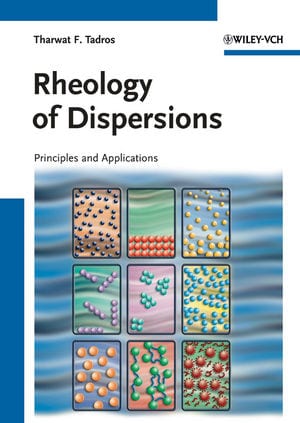 Rheology of Dispersions: Principles and Applications
Rheology of Dispersions: Principles and Applications
Tharwat F. Tadros
Hardcover
216 pages
US $235.00
Dispersions are a highly important class of complex fluids. Typical examples of dispersions are suspensions and emulsions. These complex fluids frequently occur in daily life, for example in the cosmetic industry or in coating applications. The flow characteristics of dispersions are relevant for preparation and application as well as optimization of the stability of these systems. Because of their large technological relevance, a strong need exists for a comprehensive overview on the rheological properties of these complex fluids.
A practically oriented summary on the foundations of the rheology of dispersions is presented by Tharwat Tadros in his book Rheology of Dispersions: Principles and Applications. In this book, Tadros explains in a very understandable manner the principles and foundations of the rheology of dispersions. The book is ideally suited for all researchers and users of dispersions. In the introductory chapter, the motivation for studying the rheology of dispersions is explained in an illustrative manner. Then the principal interactions between particles in dispersions are explained. Tadros succeeds in presenting all relevant details of the interaction mechanisms in a short and precise manner. In this way, the reader is able to understand the main aspects in a very efficient way. Furthermore, illustrative figures help to elucidate the physical mechanisms in dispersions.
Chapter 3 of this book is devoted to the experimental methods in order to determine the rheological quantities. A comprehensive overview on the variety of rheological methods is given. A beginner in rheology easily understands the main aspects of the measurement techniques. Furthermore, a large number of methods is described by focussing on practical aspects. Complex fluids are characterized by a viscoelastic behaviour. In the fourth chapter of his book, Tadros describes the principles of viscoelasticity of complex fluids. Different important experiments are discussed such as shear oscillations in the linear viscoelastic regime, stress relaxation experiments and creep recovery experiments. In this chapter, a very comprehensive summary is given which allows one to understand quickly the different methods in order to measure the time-dependent rheological behaviour of dispersions.
In the first four chapters, the principal interactions in dispersions and the foundations of rheology are presented. In the following chapters, different types of dispersions are discussed in detail. The rheology of suspensions is the topic of Chapter 5. The influence of the volume fraction of the dispersed phase on viscosity and dynamic moduli is a main subject. Theoretical results and experimental data are presented. The main formulas are given and their relevance is exemplified using data of different systems such as sterically stabilized and flocculated suspensions.
Emulsions are a further important class of dispersions which have been studied in detail.In Tharwat Tadros’ book, the governing mechanisms in emulsions are presented. Important theoretical and experimental results for emulsions are explained. The relevance of the capillary number is discussed in detail. Deformation and break-up of droplets are further subjects in this chapter on emulsions.
For practical purposes, gels and thickeners are frequently used. These kinds of dispersions are a topic in this book. In particular, the time-dependent behaviour of gels and the influence of the microstructure on the flow properties are presented in an illustrative manner. In the final chapter, the stability of the microstructure of dispersions is discussed. The physics of sedimentation and creaming phenomena are clearly explained. Rheological methods are suited to analyze the the long-term stability of dispersions.
The book of Tharwat Tadros is characterized by a clear structure which allows one to get a comprehensive overview on the rheology of dispersions. Precise explanations are presented, and useful references are given at the end of each chapter. Tadros’ book presents an optimum balance between precise theoretical explanations and practical aspects. In summary, the book “Rheology of Dispersions” by Tharwat Tadros can be highly recommended for practically oriented researchers working in the field of dispersions.

















